Viewing and imaging beautiful doubles is fun and easy however they often go unnoticed. You don't need any special equipment but binoculars and telescope give you hundreds or thousands of wonderful targets. Doubles do not demand you drive out of the city. Doubles do not require a new Moon phase. So you can view them anywhere and any time it's clear.
perspective
Double stars do not get the same consideration as other celestial phenomena. Typically, "what’s up in the sky" talks discuss solar system events and some deep sky objects, including galaxies, asteroid occultations, and variable stars.
The last 10 years of RASC Journals are devoid of articles on double stars. Many years ago Alister Ling wrote about discovering a double star during a lunar occultation.
To be fair, doubles are addressed in RASC materials. They are noted in the Observer's Handbook (link) with some text and two tables. The RASC Explore the Universe observing programme (link) includes some double star targets.
Blake Nancarrow delivered the following double star presentation at the 21 February 2018 Recreational Astronomy Night Meeting at the Ontario Science Centre. The edited video is available on our YouTube channel.
is a double double?
The definition of "double" means two equal, identical, or similar things. It often conjures the image of two similar stars close together.
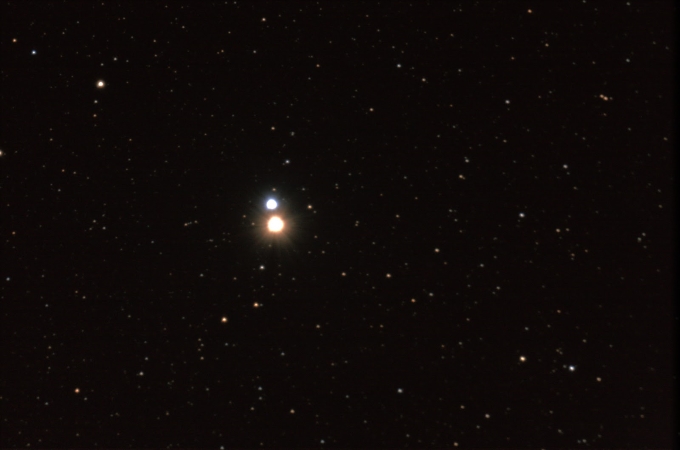
Albireo (β Cygni) is one of the most famous pair of bright and colourful stars (image above).
When people refer to double stars, they are not always talking about two stars. "Double" is used informally to refer to a small group of stars. Multi-star systems might have 3 or 5 companions. Many "double stars" lists often combine pairs and triples.
The Trapezium has a few stars. A low-power view of the group in the Orion Nebula will show 4 bright stars. Higher magnification reveals 2 more stars.
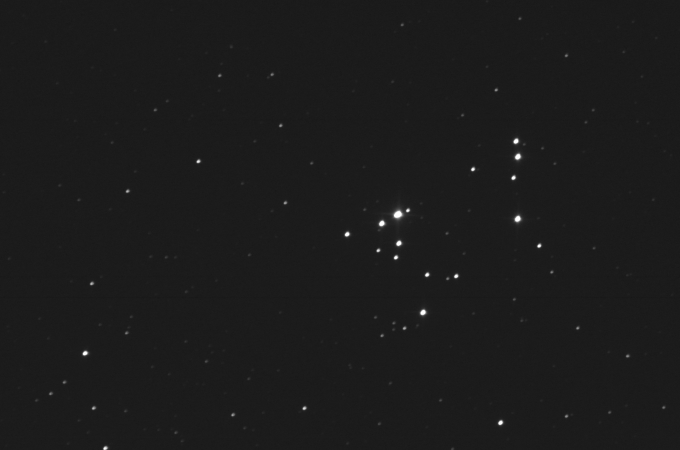
Extreme examples of multi-star systems include U Sagittarii with 18 elements and 15 Monocerotis with 21! Often these families are found in open clusters. Σ848 (above) is also referred to as the 37 Cluster.
The convention used to identify individual stars in a double or multi-star system is letters starting with A. The "A" star marks the primary and is the brightest member (normally). The "B" star is the secondary and is (usually) a bit dimmer. Then "C" and "D" and so on.
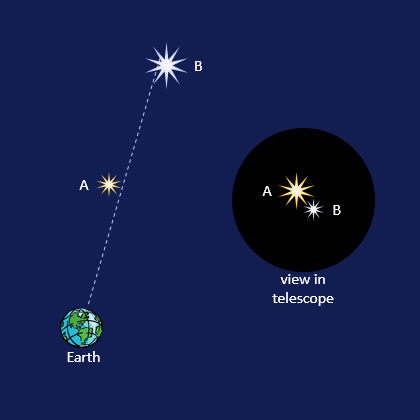
A number of double stars are "optical." From our perspective here on Earth (see graphic above), these doubles are due to a chance alignment. We have one star in the foreground and the other behind.
Stars can be close together. Members of an open cluster may be less than a light-year apart. They are gravitationally bound, are considered a "physical" system, and exhibit the same proper motion. If very close, stars might be astronomical units (AU) apart.

Binary double stars orbit each other. Binary systems can have long or fast orbital periods. Viewing binaries can be intriguing when the periods are 100 years or less, for the observer can see the stars change position. Graphic above from SkyTools. Accurate measurements can help calculate orbital parameters and masses of stars, which like variable star research, can be very important.
The term "binary" is used somewhat frequently to refer to an interacting pair of stars; however, some people use the word without formality to refer to an optical pair.
"Double" is used casually to refer to two or more stars close together. "Let's look at some double stars, and triples, and quads, oh, a few quintuples, and some multi-star systems tonight!" is a bit of a mouthful.
characteristics
A deep sky object often looks grey or grey with a greenish tint. A most pleasing aspect of double stars is colour. Real colour. That's part of the reason why I recommend adding them to observing campaigns and showing them at star parties. The hues result is many exclamations.
Miram is light orange with a blue-green companion. 11 and 12 Camelopardalis are blue-white and deep orange. WZ Cassiopieia is a pair of orange and blue stars. Struve 1064 is a fantastic triple: yellow, red, and blue. Sometimes the colours are very subtle like off-white and very pale yellow. Many use jewel references like topaz and pearl. Descriptions are subjective.
Consider the basic stellar classification scale. O and B stars are intense blue-white hot stars while K and M class stars are orange and red cool furnaces. The stars in the middle, A, F, and G, may seem white but near another star show a hint of blue or lemon-white.
You may experience changes in colour at different magnifications. Alnitak A and B at low power look the same; at 200x, they are subtly different, white-blue and dusty yellow. Also your eyepieces may have slight colour.
Consider the amount of air you're going through. Stars at a low elevation will take on colour.
In your log notes be sure to record your impressions of colour, whether muted or pronounced. Bear in mind there's no right or wrong answer. Transcribe what comes to mind. Don't forget to note the power used and how low the target was.
Another aspect of double stars is their proximity to each other.
The distance between stars is known as angular separation. We use degrees (°), minutes ('), and seconds ("). The two stars of 22 Orionis are 242" apart. θ 1 and 2 in Taurus are separated by 5.6 minutes of arc. Albireo A and B are about 35 arc-seconds apart.
Suggested targets from magazines or handbooks will often quote separation. That can tell you how challenging a target may be. Or what is the best instrument to use to view the target.
There are no official terms you must follow. Use descriptions such as "very wide" or "wide," "pleasingly close" or "attractively close," "tight," "very tight," and "extremely close." Some will refer to the space between the stars. One book suggests phrases like "split by a tiny gap" or "split by a hair." When two stars are extremely close, they will appear to be touching or "kissing." Some use descriptors like peanut-shaped, a snowman, or a figure-8.
How tight or separated stars are is impacted by magnification. At low power, you may not be able to see two distinct points; at high power, you may find it easy. Try different zoom levels. Consider very high powers. Experienced double star observers will say there's no upper limit.
You may not split two stars. You may not be able to visually separate or see each star in a very tight double and that’s OK. Enter in the log book "Not splittable." Note the conditions and any other factors and leave it for another day.
If just starting out with doubles, get to know your lower limits and enjoy pairs with wide separations. If you like challenges then you can go for increasingly tighter pairs.
When a pair of close stars have the same colour and brightness, it might make you think of a vehicle's headlights. Or animal eyes. Most are different. The difference in magnitudes is an interesting feature of double stars.
This is another item to make note of in your log book. When viewing doubles just for fun, make a remark like "The companion is very faint compared to the primary." As you observe more, you may get a sense of the mag difference. Try to estimate this.
If very different, the glare from a bright star can overwhelm the scene. Stars of equal brightness can be quite close together; if they are dramatically different in magnitude, it is likely they will need to be further apart.
Do the best you can. There's no trophy for splitting a particular double star. But it is helpful knowing that a bright primary may prevent you from tagging a dim secondary.
If you have an occulting eyepiece, try blocking the bright star.
Doubles are fun to look at for many reasons. They are usually colourful. They can be identical but are usually dissimilar. The differences can be stark or subtle. Pairs come in every possible configuration and they appear at different angles and distances. They can be very easy but also extremely tough. Some observers rise to the challenge pushing their equipment and pushing themselves.
simple gear
You can observe with doubles just your eyes. Assuming you have good eyesight or an up-to-date prescription, you should be able to tag a dozen or so double stars. Jerry Lodriguss has a nice target list of naked eye double stars with tips on his AstroPix web site.
If you have binoculars, you're in good stead. The most common type, 7x50, can reveal 150 000 stars. You should be able to see hundreds of doubles. Ideally, you'll want your binos stabilised on a tripod.
You don't have to buy a telescope. If you have a telescope, you don't have to upgrade it. With a telescope and a couple eyepieces, your eligible candidates grows to thousands. Sissy Haas's popular book lists 2100 "stellar gems" and they are all magnitude 8 or brighter. That's easy stuff for a 3-inch telescope.
Some will say that certain telescopes types are better for double star observations. All telescopes work fine.
Photographing double stars introduces other challenges but the telescope itself need not be a limiting factor. Also, double star exposures are usually very short or fast so you may not need to worry about guiding.
To view doubles, you can "run what you brung."
freedom
When can you do double star observing? Anywhere. Any time!
Double star observations, like variable star comparisons, have you working with stars--point source objects. Unlike galaxies or comets, which have their light spread out over a extended area, the starlight is concentrated. That beam of photons can punch through a less-than-perfect sky. Haze and average transparency will not stop you. Many consider that when the Moon is up, no astronomy can be done when you can view many double stars.
Depending your targets, how tight some of the companions are, you might prefer good seeing. But don't wait for that. Simply log the sky conditions. If it's really poor, forego the tighter twins.
We can observe stars amidst bright city lights. If the magnitude of your targets stars is better than the background sky brightness, you're OK to go.
When we view doubles we don't need to try to maintain a level of dark adaptation nearly to the degree we would if hunting for galaxies. So if the forgetful neighbours leave their back light on, you should be OK.
Doubles do not demand you drive out of the city. Doubles do not require a new Moon phase. If it's suddenly clear in the middle of the week, get outside. If you have a good backyard or a nice balcony, use it. If you have a grab-and-go telescope, you can knock down a few new double stars on any clear night.
Avoid artificial bad seeing. Keep in mind that if you look at objects just above the roof line of a neighbour's house, the radiant heat may disturb the view.
ideas
While RASC does not have a formal double star observing certificate programme, there are some double star targets in the Explore The Universe (ETU) campaign.
The RASC Observer’s Handbook contains two tables of targets. The first selection includes over 135 double and multiple stars. They are generally tight and therefore require a telescope. Some targets are binary systems where the companion star is moving year by year in relation to the primary.
The other RASC table is a collection of colourful systems. The list showcases 100 gems.
All the astronomy magazines generally discuss double stars. Some feature a column that focuses on a constellation and all the interesting objects within. Sometimes there is a special piece that emphasises on some aspect of double star observing.
The Sky & Telescope magazine regularly discusses doubles. As well, they host many articles on their web site. There are items for those getting started, that discuss colour perception, and how to measure doubles. They have lists with summer or winter targets.
The Evening Sky Map is a downloadable list and chart, produced monthly, that features an all-sky map like a planisphere. The calendar notes special events for the time period. The second page of TESM list suggests targets arranged by instrument. The bino and 'scope sections include some attractive doubles.
Visit the Astronomical League web site. They encourage double star observing through their certifications and double star club.
There are two campaigns designed for binoculars and one for telescopes. The basic bino programme has a master list of 120 targets but you only need to complete 50 entries. The advanced programme is similar. The telescopic targets are tighter and all 100 must be logged.
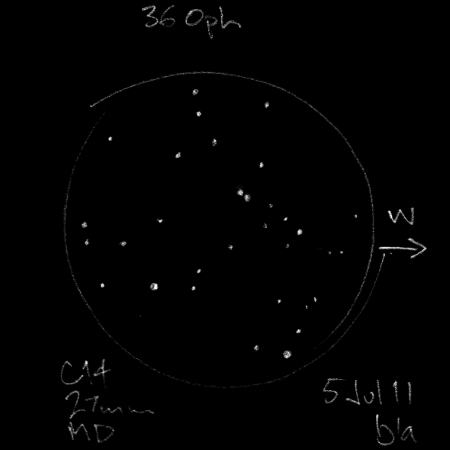
The AL requires that sketches be submitted with one's log. That may be off-putting but arguably double star sketches are the easiest to draw.
resources
Perhaps the most famous book is double stars for small telescopes by Sissy Haas. It includes 2100 entries organised by constellation.
Many paper charts or atlases will show double stars as a disc with a stick or stroke. At first glance, it might look like the sky is filled with Saturns but the lollipop icon is meant to indicate a telescopic double star. The Cambridge Atlas of Double Stars with maps by Tirion is no exception.
Just about any astronomical software application will show double stars.
The stars in apps are usually rendered realistically. And when you zoom, a single star will break apart into components. The popular Stellarium and SkySafari programs are good examples of apps trying to show celestial objects with high realism.
When a binary system with known-good orbital data is selected in SkyTools, you can plot the path of the secondary. This shows how the partner will move over time. AstroPlanner has similar capabilities.
designations
I note a handful of double star discoverers. Their catalogues show designations with their name or code followed by a number. Multiple Nair al Saif is also known as HD 37043 and officially noted as STF 752 in the Washington Double Star (WDS) database.
The table shows the historical details including the discoverer's name, the code or symbol, and the text reference.
| discoverer | active circa | code | WDS tag |
| Friedrich Struve | 1830-1850 | Σ | STF |
| Otto Struve | 1840-1860 | OΣ | STT |
| William Herschel | 1790-1815 | H or H N | |
| John Herschel | 1820-1840 | h or HJ | |
| Henry Draper | 1860-1880 | HD | |
| James South | 1820 | S or SHJ | |
| James Dunlop | 1830 | Δ | DUN |
| Sherburne Burnham | 1870-1900 | β | BU or BUP |
Note: Burnham's doubles are shown with the beta Greek symbol which can make for some confusion. Triple star δ Cephei is also known as β 702. Do not mistake the beta reference as the beta star in Cepheus, i.e. the second star according to the Bayer designation.
See the WDS for more information.
getting started
I note some suggestions with the common name and constellation code. You should be able to easily find them in your favourite astronomy app or atlas.
- Mizar & Alcor, UMa
- Castor, Gem
- “Tim Horton,” aka Double-Double, Lyr
- Sulafat, Lyr
- Polaris, UMi
- Rasalgethi, Her
- Miram, Per
- “Winter Albireo” aka h3945, CMa
- φ (phi) Tauri
- T Draconis
- 70 Ophiuchi
Notes:
Mizar with Alcor is a fun system. Starting with just your eyes, you should be able to see a faint point of light near Mizar. That's Alcor. With binoculars, Alcor or 80 UMa will be far from Mizar. With high-power binoculars or a small telescope, Mizar aka ζ (zeta) UMa will split into pieces. Mizar B is very close to A. Telescopic views will often reveal the faint and unrelated star between, Sidus Ludoviciana aka HD 116798.
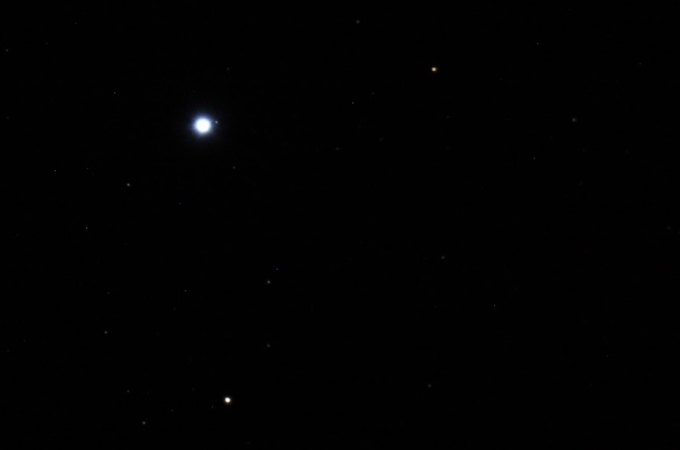
Sulafat (above) aka gamma Lyrae is an excellent example of a dramatic pair where the primary is very bright (magnitude 3.2) while the delicate companion (mag 12.1) is almost overwhelmed in the glare.
The “Winter Albireo” or h3945 in Canis Major is a very colourful double evocative of the summer gem. They are closer than β Cyg. Also known as: HR 2764, HIP 35210, or 145 CMa.
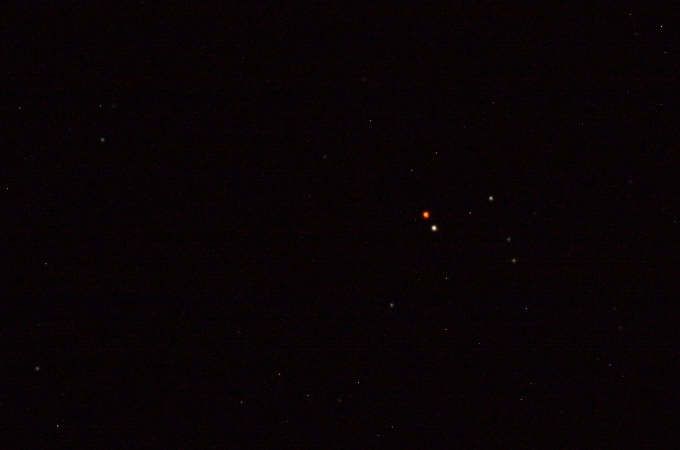
T Draconis (above) or ES 20 is a stunning representation of colour. The primary is M-class hence the deep orange or red colour. It is a variable star ranging between magnitudes 7 and 13 over 420 days. This means that the primary star is sometimes dimmer than the off-white or beige mag 11 companion.
70 Ophiuchi aka Σ2272 is one of the "fast movers." The binary pair orbit is approximately 88 years. As of July 2017, the B star was about 12 arc-seconds from A, near maximum separation. Check them every summer.
observing
If you have never or rarely viewed double stars, I hope you'll consider these objects for future observing sessions. If you already observe doubles, I hope this rekindled your interest and that you'll try for some new and more challenging quarries. Go for tighter pairs or unequal close pairs.
If you have wondered what to do on clear evenings when stuck in the city or clear evenings when the Moon is up, you can add some doubles to your plan and get more photons in the backyard any time the weather is good.
Assuming you keep logs of your observations, remember to note the colours of each element. Compare the colours of the target to the field stars, if any. Describe how far apart or close they are or if they are touching. Note your eyepieces or magnification. Gauge the seeing conditions.
Remember: you don’t have to split them! Just view and enjoy these amazing distant suns.
closing
I trust this discussion has been intriguing and invigorating. Viewing and imaging beautiful doubles is fun and easy. They can be challenging. Binary systems are dynamic and exciting to watch over time. I encourage you to do more double star observing and photography.
Encourage others to view doubles. Share the view when you find a cool double. At member and public events, like observing sessions, star parties, weekends at the observing, backyard observing with friends and family, talk about double stars.
Viewing double stars with others is especially fun. Each observer may have a different impression of the colours so it is interesting to compare. An experienced observer or one with exceptional vision might spot close companions or faint partners and then help give clues to others.
If there's sufficient interest, more presentations and articles can be planned. We could run double star workshops.
I am happy to help you. If you have questions or want more information, do not hesitate to reach out.
Be seeing you. Contact Blake Nancarrow astronomy at computer-ease dot com for errors, omissions, questions.

